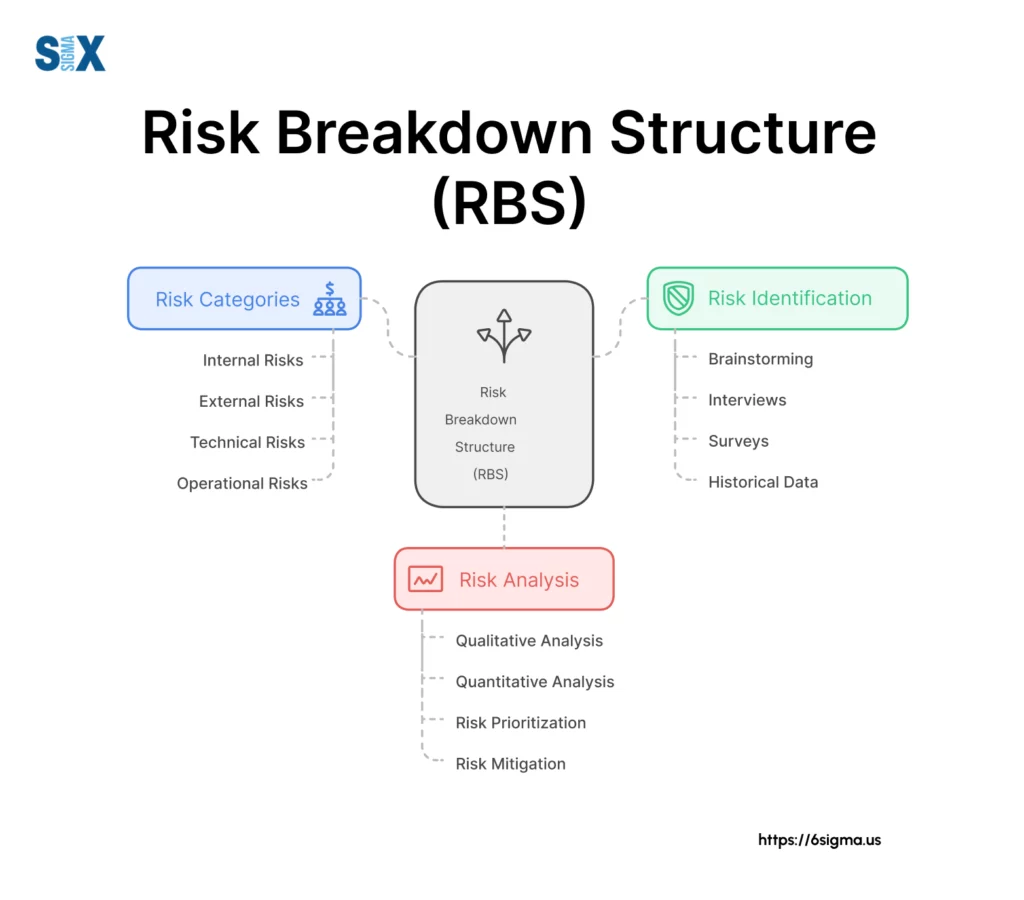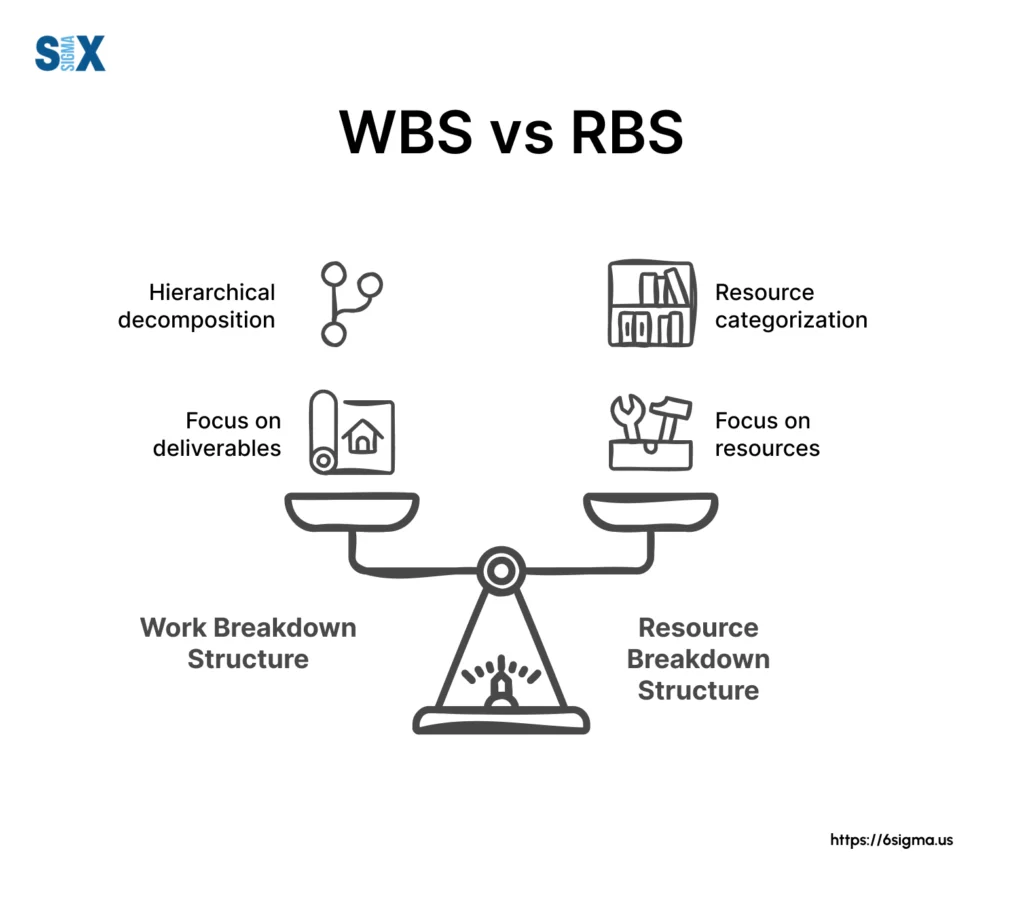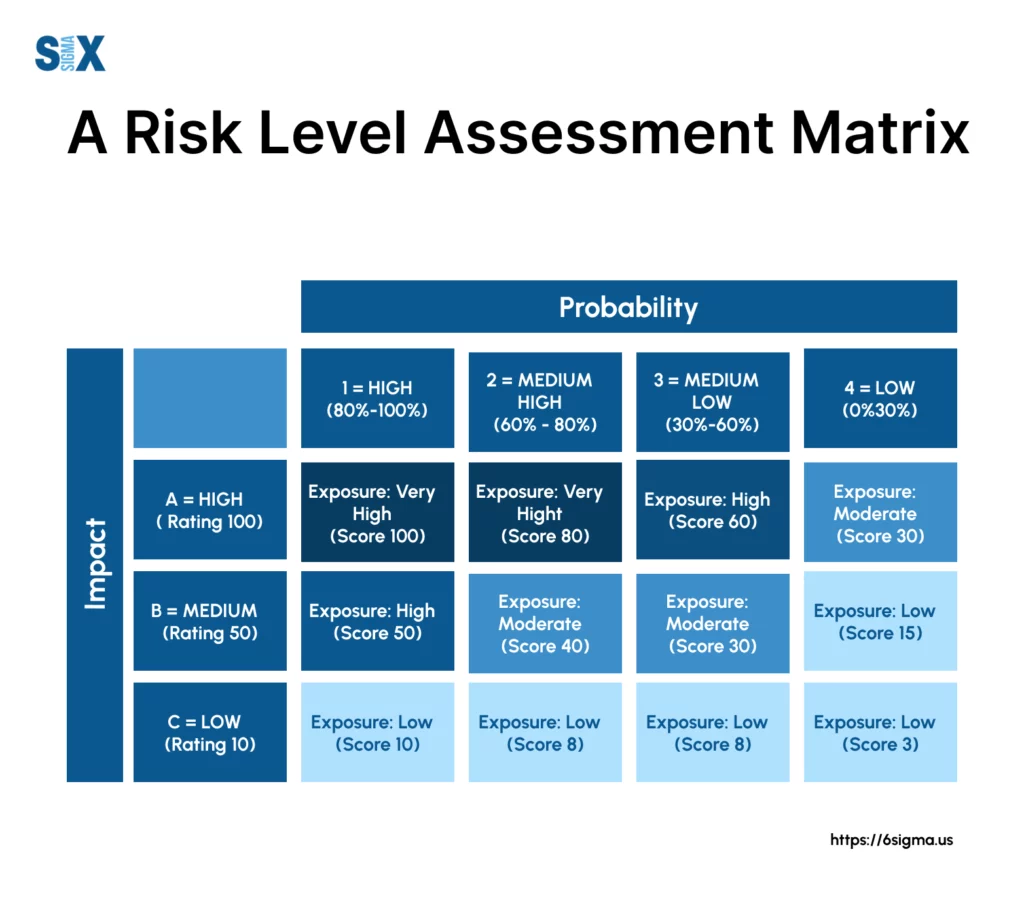The Importance of Using a Risk Breakdown Structure in Project Management
One of the most powerful tools in a project manager’s arsenal is the Risk Breakdown Structure (RBS).
The RBS is a hierarchical representation of potential project risks, providing a structured approach to identifying, categorizing, and analyzing risks that could impact project objectives.
Key Highlights
- Definition and purpose of Risk Breakdown Structure (RBS)
- Hierarchical structure and common risk categories
- Steps to develop an effective RBS
- Risk assessment and analysis techniques using RBS
- Implementing RBS in project risk management
Understanding Risk Breakdown Structure (RBS)
To effectively manage project risks, it’s crucial to have a structured approach.
The Risk Breakdown Structure (RBS) provides exactly that, offering a systematic way to identify and categorize potential risks.
Definition and Purpose of Risk Breakdown Structure (RBS)
A Risk Breakdown Structure (RBS) is a hierarchical representation of potential project risks, organized by risk category and subcategory.
Its primary purpose is to provide a comprehensive framework for identifying, categorizing, and managing risks throughout the project lifecycle.
By structuring risks in this manner, project managers can ensure a thorough risk identification process and facilitate more effective risk management strategies.
The RBS serves as a valuable tool in project risk management, allowing teams to:
- Systematically identify potential risks
- Categorize risks based on their nature and impact areas
- Prioritize risks for analysis and response planning
- Facilitate communication about risks among stakeholders
- Provide a foundation for risk monitoring and control

How RBS Fits into Project Risk Management
The Risk Breakdown Structure is an integral part of the overall project risk management process.
It aligns closely with a risk management framework, which includes risk identification, analysis, response planning, and monitoring.
In the risk identification phase, the RBS serves as a checklist to ensure all potential risk areas are considered. During risk analysis, it helps in categorizing and prioritizing risks.
For response planning, the RBS provides a structured approach to developing mitigation strategies.
Finally, in the monitoring phase, it offers a framework for tracking and reporting on risk status.
Make your RBS concepts clear and understand its role in project management with Lean Six Sigma Yellow Belt
Differences Between Risk Breakdown Structure (RBS) and Work Breakdown Structure (WBS)
While both the Risk Breakdown Structure (RBS) and Work Breakdown Structure (WBS) are hierarchical decomposition tools, they serve different purposes in project management:
- Focus: The WBS breaks down the project scope into manageable work packages, while the RBS breaks down potential project risks.
- Content: WBS contains project deliverables and activities, whereas RBS contains risk categories and specific risks.
- Purpose: WBS is used for scope management and project planning, while RBS is used for risk identification and management.
- Timing: WBS is typically created early in the project planning phase, while RBS is developed and refined throughout the project lifecycle.
- Flexibility: WBS is relatively stable once created, but RBS is more dynamic, evolving as new risks are identified or existing risks change.

Components of a Risk Breakdown Structure
Understanding the structure and components of an RBS is crucial for its effective implementation.
Hierarchical Structure and Levels
A typical Risk Breakdown Structure consists of multiple levels, organized in a hierarchical manner:
- Level 0: The project name or overall risk exposure
- Level 1: Major risk categories (e.g., Technical, Management, Commercial, External)
- Level 2: Subcategories within each major category
- Level 3: Specific risk events or sources
Each level provides increasing detail, allowing for a comprehensive view of potential risks.
The number of levels can vary depending on the project’s complexity and the desired level of detail in risk management.
Common Risk Categories in Risk Breakdown Structure
While risk categories can vary depending on the project and industry, some common categories found in many Risk Breakdown Structures include:
- Technical Risks: Related to technology, requirements, performance, quality, etc.
- Management Risks: Involving project management, resource allocation, communication, etc.
- Organizational Risks: Associated with the company’s structure, policies, and culture
- External Risks: Including market conditions, regulatory changes, natural disasters, etc.
- Commercial Risks: Related to contractual issues, suppliers, vendors, etc.
- Environmental Risks: Concerning sustainability, ecological impact, etc.
Risk Identification and Classification Techniques
To populate the RBS with relevant risks, various identification and classification techniques can be employed:
- Brainstorming sessions with project team and stakeholders
- Review of historical data from similar projects
- SWOT analysis (Strengths, Weaknesses, Opportunities, Threats)
- Delphi technique for expert opinion gathering
- Root cause analysis to identify underlying risk factors
- Checklist-based approaches using industry-standard risk categories
Once identified, risks are classified into the appropriate categories and subcategories within the RBS, providing a structured overview of the project’s risk landscape.
Creating an Effective Risk Breakdown Structure
Developing a robust Risk Breakdown Structure is a critical step in project risk management.
Steps to Develop a Risk Breakdown Structure (RBS)
- Define the project scope and objectives
- Identify major risk categories relevant to the project
- Break down each category into subcategories
- Conduct risk identification sessions with stakeholders
- Populate the RBS with identified risks
- Review and refine the structure for completeness and clarity
- Validate the RBS with key stakeholders
- Integrate the RBS with the project risk management plan
Risk Breakdown Structure Templates and Examples
While each project may require a unique RBS, starting with a template can save time and ensure comprehensiveness.
Some common RBS templates include:
- PMI Standard RBS Template
- Industry-specific RBS templates (e.g., IT, Construction, Healthcare)
- Organization-specific templates based on historical projects
Example: A simplified RBS for a software development project might look like this:
- Level 0: Software Development Project Risks
- Level 1: Technical Risks
- Level 2: Requirements Risks
- Level 3: Incomplete requirements
- Level 3: Changing requirements
- Level 2: Technology Risks
- Level 3: Incompatible technologies
- Level 3: Performance issues
- Level 1: Management Risks
- Level 2: Resource Risks
- Level 3: Skill shortages
- Level 3: Resource availability
- Level 2: Schedule Risks
- Level 3: Unrealistic deadlines
- Level 3: Dependency delays
Integrating RBS with Project Scope and Planning
The Risk Breakdown Structure should be closely aligned with the project’s scope and overall planning:
- Map RBS categories to WBS elements to ensure comprehensive risk coverage
- Use the RBS to inform risk management activities in the project schedule
- Incorporate RBS-identified risks into project cost estimates and contingency planning
- Align RBS with project objectives to prioritize risk management efforts
- Use RBS to guide risk-related communications with stakeholders
By integrating the RBS with other project management tools and processes, you ensure a cohesive approach to risk management throughout the project lifecycle.
Learn the detailed explanation of RBS development and integration with Lean Six Sigma Green Belt.
Risk Assessment and Analysis Using Risk Breakdown Structure (RBS)
Once the Risk Breakdown Structure is in place, it serves as a foundation for comprehensive risk assessment and analysis.
Qualitative and Quantitative Risk Analysis Methods
Qualitative Risk Analysis:
- Risk Probability and Impact Assessment: Evaluate the likelihood and potential effect of each risk
- Risk Categorization: Group risks based on their sources or areas of impact
- Urgency Assessment: Determine which risks require near-term responses
- Expert Judgment: Leverage experience and expertise to assess risks
Quantitative Risk Analysis:
- Expected Monetary Value (EMV) Analysis: Calculate the potential financial impact of risks
- Decision Tree Analysis: Evaluate potential outcomes of different risk response strategies
- Monte Carlo Simulation: Model the combined effect of multiple risks on project objectives
- Sensitivity Analysis: Determine which risks have the most significant impact on the project
Risk Scoring and Prioritization Techniques
To effectively manage risks identified in the RBS, it’s crucial to prioritize them based on their potential impact and likelihood:
- Risk Score Calculation: Multiply probability and impact ratings to get a risk score
- Risk Ranking: Order risks based on their scores from highest to lowest
- Pareto Analysis: Focus on the top 20% of risks that may cause 80% of the impact
- Risk Urgency Assessment: Consider the timeframe in which risks may occur
- Multi-Criteria Decision Analysis: Use multiple factors to prioritize risks
Probability and Impact Matrix in Risk Breakdown Structure (RBS)
The Probability and Impact Matrix is a powerful tool for visualizing and prioritizing risks within the RBS:
- Create a matrix with probability on one axis and impact on the other
- Plot each risk from the RBS on the matrix based on its assessed probability and impact
- Define risk thresholds (e.g., high, medium, low) on the matrix
- Use color-coding to highlight risk severity (e.g., red for high, yellow for medium, green for low)
- Prioritize risks falling in the high-risk (red) areas of the matrix
This visual representation helps stakeholders quickly understand the most critical risks and where to focus risk management efforts.
Implementing Risk Breakdown Structure (RBS) in Project Risk Management
The true value of a Risk Breakdown Structure is realized when it’s effectively implemented within the project risk management process.
RBS as Part of the Risk Management Process
- Risk Identification: Use the RBS as a checklist to ensure all risk areas are considered
- Risk Analysis: Leverage the RBS structure to categorize and group risks for analysis
- Risk Response Planning: Develop strategies aligned with RBS categories
- Risk Monitoring and Control: Use the RBS to track risk status and trends
Integrate the RBS into your risk management plan, ensuring it’s referenced and updated throughout the project lifecycle.
Risk Mitigation and Response Strategies
Develop risk response strategies for each category in the RBS:
- Avoidance: Eliminate the threat or protect the project from its impact
- Transference: Shift the impact of a threat to a third party
- Mitigation: Reduce the probability and/or impact of a threat
- Acceptance: Acknowledge the risk and be prepared to address it if it occurs
Ensure that response strategies are appropriate for the risk category and align with overall project objectives.
Risk Monitoring and Reporting Using Risk Breakdown Structure (RBS)
The RBS provides a structured framework for ongoing risk monitoring and reporting:
- Regular Risk Reviews: Schedule periodic reviews of risks within each RBS category
- Risk Status Updates: Track changes in risk probability, impact, or overall status
- Risk Trend Analysis: Monitor how risks evolve over time within RBS categories
- Stakeholder Reporting: Use the RBS structure to organize risk reports for stakeholders
- Lessons Learned: Capture insights on risk management effectiveness for each RBS category
Implement a system for tracking and reporting risks that aligns with the RBS structure, enabling efficient communication and decision-making throughout the project.

Conclusion
As we wrap up our comprehensive exploration of the Risk Breakdown Structure (RBS), let’s reflect on its significance in project risk management and look ahead to future trends.
- Structured Approach: RBS provides a systematic method for identifying and categorizing project risks
- Comprehensive Coverage: Ensures all potential risk areas are considered
- Improved Communication: Facilitates clear risk discussions among stakeholders
- Enhanced Analysis: Supports both qualitative and quantitative risk analysis techniques
- Efficient Monitoring: Offers a framework for ongoing risk tracking and reporting
Remember, the true value of an RBS lies not just in its creation, but in its consistent application and refinement throughout the project lifecycle.
As project environments become increasingly complex and dynamic, the structured approach offered by RBS will become even more crucial for effective risk management.
As you move forward, consider how you can leverage RBS in your projects and contribute to its evolution in the field of project management.
The future of risk management is structured, informed, and proactive—and the RBS is at its core.
SixSigma.us offers both Live Virtual classes as well as Online Self-Paced training. Most option includes access to the same great Master Black Belt instructors that teach our World Class in-person sessions. Sign-up today!
Virtual Classroom Training Programs Self-Paced Online Training Programs







